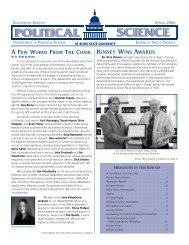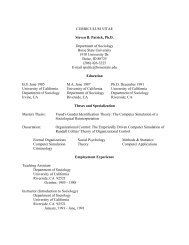Late Glacial Environments and Paleoecology at Blackwater Draw ...
Late Glacial Environments and Paleoecology at Blackwater Draw ...
Late Glacial Environments and Paleoecology at Blackwater Draw ...
Create successful ePaper yourself
Turn your PDF publications into a flip-book with our unique Google optimized e-Paper software.
80 CHRISTOPHER L. HILL, FRED WENDORF, PAUL B. SEARS AND EDNA PAPAZIAN<br />
Fig. 2. Image of sedimentary remnant in vicinity of Highway Site <strong>and</strong> Barrow Pit.<br />
Scale is 10 centimeters = 4 inches. Photo taken in 1998 by C. Hill.<br />
the south of Baseline Road, two localities have been<br />
design<strong>at</strong>ed: the Barrow Pit (Locality 7, Haynes 1975)<br />
<strong>and</strong> the nearby Highway Site (LA 3325, Hester 1972)<br />
(Fig. 1 <strong>and</strong> 2).<br />
Here, we initially describe the sedimentary sequence<br />
<strong>at</strong> the Barrow Pit following the str<strong>at</strong>igraphic terminology<br />
of Haynes (1975; see also Haynes <strong>and</strong> Agogino<br />
1966:815). <strong>L<strong>at</strong>e</strong>r, we compare the str<strong>at</strong>igraphic sequence<br />
with other environmental studies th<strong>at</strong> have<br />
used a variety of str<strong>at</strong>igraphic design<strong>at</strong>ions for localities<br />
in <strong>and</strong> near the draw. The lowest deposit, unit B1,<br />
consists of a speckled s<strong>and</strong>. It is overlain by unit B2,<br />
a lamin<strong>at</strong>ed lacustrine mudstone. A sample of carbon<strong>at</strong>e<br />
from the lower part of the mudstone has a radiocarbon<br />
measurement of about 15,770 B.P. (A-669B, Haynes<br />
1975, B.P. = radiocarbon years before present). The<br />
upper part of unit B2 contains a well-developed,<br />
eroded calcic paleosol; Clovis points were recovered<br />
from the defl<strong>at</strong>ed surface of this paleosol (Haynes <strong>and</strong><br />
Agogino 1966).<br />
The lamin<strong>at</strong>ed mudstone is overlain by erosional<br />
remnants of s<strong>and</strong>y silt design<strong>at</strong>ed as unit D (Fig. 1<br />
<strong>and</strong> 2). Unit D contains Anodasta shells with a radiocarbon<br />
age of about 10,600 B.P. (A-493, Haynes 1975).<br />
This is correl<strong>at</strong>ed with the “di<strong>at</strong>omaceous earth” <strong>and</strong><br />
“unit D” of Haynes (1995), d<strong>at</strong>ed from 10,900–10,200<br />
B.P. <strong>and</strong> associ<strong>at</strong>ed with Folsom <strong>and</strong> Ag<strong>at</strong>e Basin artifacts<br />
<strong>at</strong> the nearby Clovis gravel pit. It could represent<br />
a local manifest<strong>at</strong>ion of the Younger Dryas. The uppermost<br />
deposit, design<strong>at</strong>ed unit E, is a calcareous silt,<br />
likely equivalent to the “carbonaceous silt” <strong>and</strong> “unit E”<br />
d<strong>at</strong>ed from 10,500/10,000 to 9,000/8,500 B.P. <strong>at</strong> the<br />
Clovis gravel pit (Haynes 1995).<br />
The str<strong>at</strong>igraphic sequence <strong>at</strong> the Barrow Pit was<br />
collected by F. Wendorf in 1965. The samples were collected<br />
from wh<strong>at</strong> was then the deepest part of the draw,<br />
in an area of numerous low hummocks (Fig. 1 <strong>and</strong> 2).<br />
The samples were sent to P. Sears who supervised the<br />
pollen analysis undertaken by E. Papazian. The area of<br />
the Highway Site <strong>and</strong> the Barrow Pit was visited by Hill<br />
in 1983, 1986, <strong>and</strong> 1998. A brief visit was conducted in<br />
2006 by Wendorf <strong>and</strong> Hill with David B<strong>at</strong>ten, Christy<br />
Bednar, <strong>and</strong> Cheryl Hill. In addition, Hill conducted<br />
a taxonomic study of the paleontological m<strong>at</strong>erials from<br />
the Blackw<strong>at</strong>er <strong>Draw</strong> region stored <strong>at</strong> the Shuler Museum<br />
<strong>at</strong> the Institute for the Study of Earth <strong>and</strong> Man,<br />
Southern Methodist University.<br />
Biostr<strong>at</strong>igraphic Description. Two of the str<strong>at</strong>a <strong>at</strong><br />
the Barrow Pit contain biotic m<strong>at</strong>erials th<strong>at</strong> can be used<br />
to evalu<strong>at</strong>e <strong>L<strong>at</strong>e</strong> Pleistocene ecological conditions within<br />
Blackw<strong>at</strong>er <strong>Draw</strong>. Pollen <strong>and</strong> molluscs are present in<br />
some of the sediments of unit B2 as well as in unit D.<br />
Twenty-four samples were collected from the unit<br />
B2 <strong>and</strong> subjected to pollen analysis (Fig. 3). Pollen







